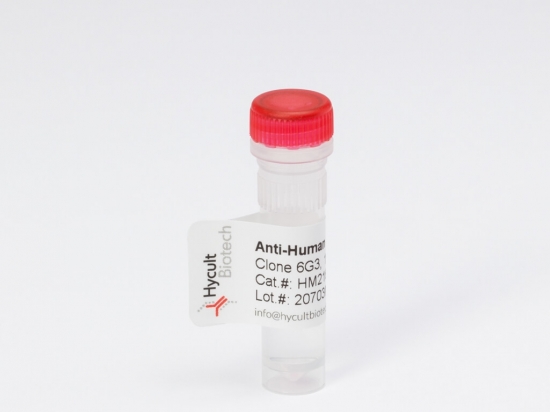TLR4/MD-2, Mouse, Monoclonal Antibody MTS510, FITC
- Supplier: Hycult Biotech
Product Description
- The monoclonal antibody MTS510 reacts with the Toll-like receptor 4 (TLR4, CD284) that is associated with MD2. TLRs are expressed by various cells of the immune system, such as macrophages and dendritic cells. TLRs are class I receptors, with a single α-helix that spans the cell membrane. They recognize and respond to molecules derived from bacterial, viral and fungal pathogens, such as lipopolysaccharide (LPS) from the outer membrane of Gram negative bacteria, peptidoglycan fragments from bacterial cell walls and single-stranded and double-stranded RNA from viruses. _x000D_
- Toll-like receptor 4 (TLR4; CD284) has been identified, next to MD-2 and CD14, as a receptor that is central to the innate immune response to LPS of Gram-negative bacteria. TLR4 is unique among TLRs in its ability to activate two distinct signaling pathways; one pathway is activated by the adaptors TIRAP (Toll/interleukin-1- receptor (TIR)-domain-containing adaptor protein) and MyD88, which leads to the induction of pro‑inflammatory cytokines. The second pathway is activated by the adaptors TRIF (TIR-domaincontaining adaptor protein inducing interferon‑β) and TRAM (TRIFrelated adaptor molecule), which leads to the induction of type I interferons. _x000D_
- MD-2 exists as a cell surface protein in association with TLR4. It also exists as secreted forms consisting of MD-2 monomer and multimers. Circulating sMD-2 is mainly present as a doublet of ~20 and 25 kD, representing differentially glycosylated forms. Unlike TLR4, sMD-2 binds directly LPS without the need of soluble CD14 (sCD14). However, LPS-MD-2 interactions are increased when LPS is pretreated with CD14. Only monomeric sMD-2 is biologically active and able to associate with TLR4 and LPS. sMD-2 circulates in plasma of healthy individuals as a non-active, polymeric protein. In septic plasma, the total amount of sMD-2 was strongly elevated and contained both sMD-2 polymers and monomers. Soluble MD-2 is proposed to be an important mediator of organ inflammation during sepsis. During experimental human endotoxemia, the monomeric and total sMD-2 content in plasma increased with the kinetics of an acute phase protein. This parallels enhanced TLR4 costimulatory activity. In vitro studies revealed that sMD-2 release appears to be restricted to endothelial and dendritic cells. _x000D_
- The monoclonal antibody MTS510 reacts preferentially, especially in flow cytometry, with mouse TLR4 that is associated with MD-2. MTS510 is a TLR4 function-blocking antibody that is useful for studies on the role of TLR4 as a receptor for LPS induced cytokine production by TLR4 bearing cells. The antibody was shown to coprecipitate MD-2 (30 kDa) with TLR4 (100 kDa)._x000D_
- Applications: Frozen sections, Flow Cytometry , Functional Studies , Immunoprecipitation
Resources
Product Options
| Product Number | Description | Package Size | List Price (CAD) | ||
|---|---|---|---|---|---|
| HYBHM1029F20UG | TLR4/MD-2, Mouse, mAb MTS510, FITC, 20 µg | 20 µg | -- | Add to Cart | |
| HYBHM1029F100UG | TLR4/MD-2, Mouse, mAb MTS510, FITC, 100 µg | 100 µg | -- | Add to Cart |
List Prices are displayed.
Please register or log-in to the site to view your organization’s prices, or please add the products to your cart and click the “Request a Quote” button to receive price and availability information (include quantities for each product and indicate either a one-time purchase or your annual usage.)



